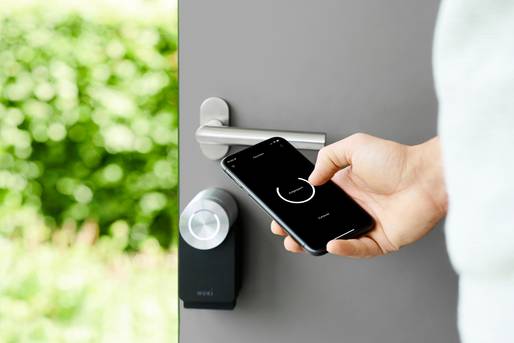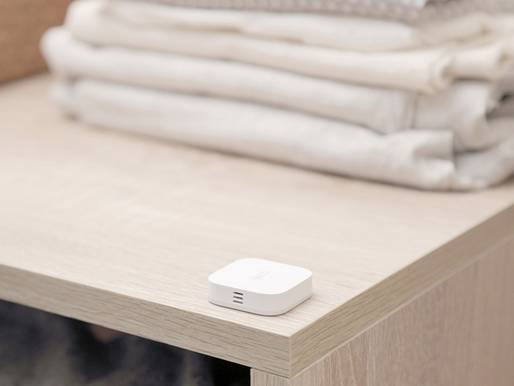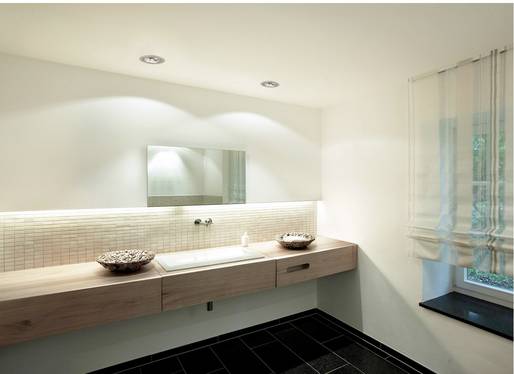Apple HomeKit » Smart Home with Siri
Updated: 28.09.2023 | Reading time: 10 minutes
We answer the most important questions about setup and compatible devices.
It is a software framework developed by Apple, i.e. a programming framework that can be used for programming. Thanks to HomeKit support, commands for devices in the smart home are assigned individually and are perfectly tailored to the application requirements.
What sounds very complex at first glance is deliberately made simple for users by Apple: The app called HomeKit is used via iPhone, iPad or Apple Watch to control compatible smart home devices. For example, you can adjust the lighting in the conference room or lock all doors at the end of the day with a click or voice-controlled via Siri.
However, a prerequisite for this simple type of application is that you are on the same network as the home devices.
An internet-enabled control center is required so that everything in the smart home system can also be operated and managed remotely via Apple devices. But even in this case, Apple makes it easy for customers, as the Apple HomePod and HomePod mini as well as Apple TV HD (4th generation) and Apple TV 4K can serve as smart control centers.
Good to know: iPad no longer possible as a control center
Apple launched the first HomeKit on the market in 2014 and also offered the option of setting up the iPad as a central hub with the earlier iOS. The latest iOS versions (more information on iOS 17) no longer support the iPad as a control center, so Apple TV or Apple HomePod are mandatory for smart home access on the go.
A wide range of device types can be integrated into the smart home or office system and used via iPhone, iPad and Apple Watch:
Sockets and switches
Smart plugs and intelligent light switches enable remote control of connected devices such as coffee machines and light sources. This can realize energy savings and is extremely convenient with just a few clicks on the iPhone or a voice command to Siri.
Lighting
Apple HomeKit enables the control of smart lighting, including Lightstrips. Users can adjust the brightness, change colors and create lighting scenarios that are tailored to their daily routines.
Thermostats
They allow you to control the room temperature and create heating and cooling schedules. This contributes to energy efficiency and comfort.
Security cameras, doorbells and locking systems
They make it easier to monitor entrance areas by sending notifications to the iPhone when visitors arrive. Depending on the system, it is possible to speak to the person directly via the iPhone.
Additional sensors
Link motion sensors, door and window sensors as well as smoke and water detectors to the system to increase general safety in all work areas.
Irrigation systems
There are HomeKit-compatible solutions for irrigation, with which you can ensure optimum and automatic watering of plants on the property.
Roller shutter and blind control
They make it possible to automate the indoor light supply and maintain a quiet working atmosphere.
Loudspeaker
Not only the HomePod with Siri is compatible with Apple HomeKit, but also a large number of speakers, soundbars and speakers.
Smart TV
Providers such as Samsung, LG and Sony use the AirPlay 2 network protocol and can therefore be connected to Apple HomeKit.
Which brands and products are compatible with Apple Homekit plays a decisive role in setting up your smart solution.
Since 2021, Apple has offered the option of making the Homekit framework usable for other manufacturers. Devices therefore do not have to be from Apple to be operated with iOS and the Home app. The quickest way to identify suitable HomeKit devices is via a certificate issued by Apple: as soon as “works with HomeKit” is noted on the device, you can add it to your system.
Here is an overview of all brands available at Conrad that are compatible with Apple HomeKit:
To connect HomeKit devices and use them in the local network, there are only a few steps to follow:
-
To set up HomeKit accessories, first switch on the respective device.
-
Open the pre-installed Home app on the iPhone or iPad, tap on the plus sign and on “Add device”.
-
The setup wizard now appears with a camera window. Use it to take a photo of the QR code attached to the HomeKit device. From iPhone 7 onwards, simply hold your smartphone near the new HomeKit product to add it.
-
Now allow the product to access the home network and complete the setup.
-
The smart device appears for operation in the Home app and can be named, assigned to rooms, integrated into scenes and more.
Linking HomeKit via WLAN
Networking devices with Apple TV
If Apple TV is to be used as the control center, “Users and accounts” and then “Standard user” must be selected in the settings to check that the desired Apple ID is active.
If this is the case, “AirPlay and HomeKit” can be selected back in the settings menu and the desired room can be entered.
Networking devices with HomePod
The Apple HomePod automatically becomes a hub and iPhone or iPad are connected via the iCloud as soon as the Apple ID is entered.
All devices can be assigned to rooms. For even more convenient use, for example in multi-storey buildings, it is advisable to divide rooms into zones (e.g. basement, first floor, upper floor) in order to control them uniformly.
If you say “Siri, switch off the lights on the first floor and in the basement”, you can be sure that all the lights in the lower part of the house will be deactivated.
Scenes and if-then automatisms offer even more benefits. This makes it possible to control several devices at the same time, regardless of the room you are in.
The app offers some suggestions for scenes for inspiration, but you can also get creative yourself.
For example, you can use the “Morning” scene to switch on the lights in the bathroom, play your favorite playlist and turn on the coffee machine, while the “Good night” scene ensures that all locks are locked and all lights are switched off.
Alternatively, you can automate processes. In conjunction with a HomePod, Apple TV or a stationary iPad, HomeKit can perform tasks automatically. This is done on the basis of set scenes depending on the time of day, location or sensors.
For example, if HomeKit detects that someone is arriving home, the lights in the entrance area are switched on while the speakers play the current playlist. It is also conceivable to only switch on lights in a room when the motion sensor is activated. Time automations can also be set so that HomeKit executes defined commands based on the time.
Apple is committed to data protection and privacy with HomeKit. As part of the Apple system, HomeKit is deeply rooted in the Apple operating systems. The closed architecture of the operating systems is designed to ensure security. The strict certification of HomeKit devices ensures that only devices authorized by Apple can access them.
Communication between HomeKit devices is end-to-end encrypted and therefore tap-proof via Apple's iCloud. Apple stores the codes required for encryption in the keychain on the iPhone and iPad, where they are secured as part of the hardware encryption. Software access to HomeKit is strictly monitored. According to Apple, messages from HomeKit devices or their status are not stored on servers at any time.
In accordance with Apple's data protection guidelines, neither Apple nor third-party apps can access data during transmission via Bluetooth, Wi-Fi or remote access. The tight HomeKit shield is limited to a certain extent by Siri: audio data can be stored for the further development of the system if you decide to share it with Apple in order to improve the Siri software. Requests via Siri are not assigned to your personal Apple ID, but to a random identifier.
With the HomeKit Secure Video feature introduced in iOS 13, Apple is dedicated to secure video surveillance. HomeKit security cameras store recordings on Apple's iCloud servers using end-to-end encryption. Only you as the user can access the encrypted video recordings without jeopardizing your privacy.
According to the manufacturer Apple, HomeKit routers can provide an additional layer of security for the smart home by protecting every device in the HomeKit system with a firewall. Should an attack on one component of the system occur one day, all other devices are still protected. Basic settings relating to the communication of the individual components in the personal network and on the internet are made via the app. Routers that are compatible with HomeKit come from providers such as Eero, Linksys or Charter Spectrum.
How are the devices controlled in Apple HomeKit?
Most people use the Home app on their smartphone or Apple Watch for manual entries. Alternatively, voice commands are possible via Siri.
Is Bluetooth sufficient as an interface?
Devices can also be connected over short distances via Bluetooth. However, the short-range radio is of little use as soon as commands are to be issued outside the radius. Wi-Fi is therefore preferred over Bluetooth.
What advantage does Apple HomeKit offer?
The decisive advantage is the integration of different brands and devices. A manufacturer-independent system can be created that is controlled via an app or Siri. Otherwise, if you use several devices from different manufacturers, you quickly have countless apps and have to open a different one for each function. This is hardly suitable for everyday use.
What to do if products are not compatible?
The simple plug-and-play installation requires Apple's certificate, but users with IT knowledge can use the free Homebridge software, for example, and turn their Raspberry Pi into a control center.




